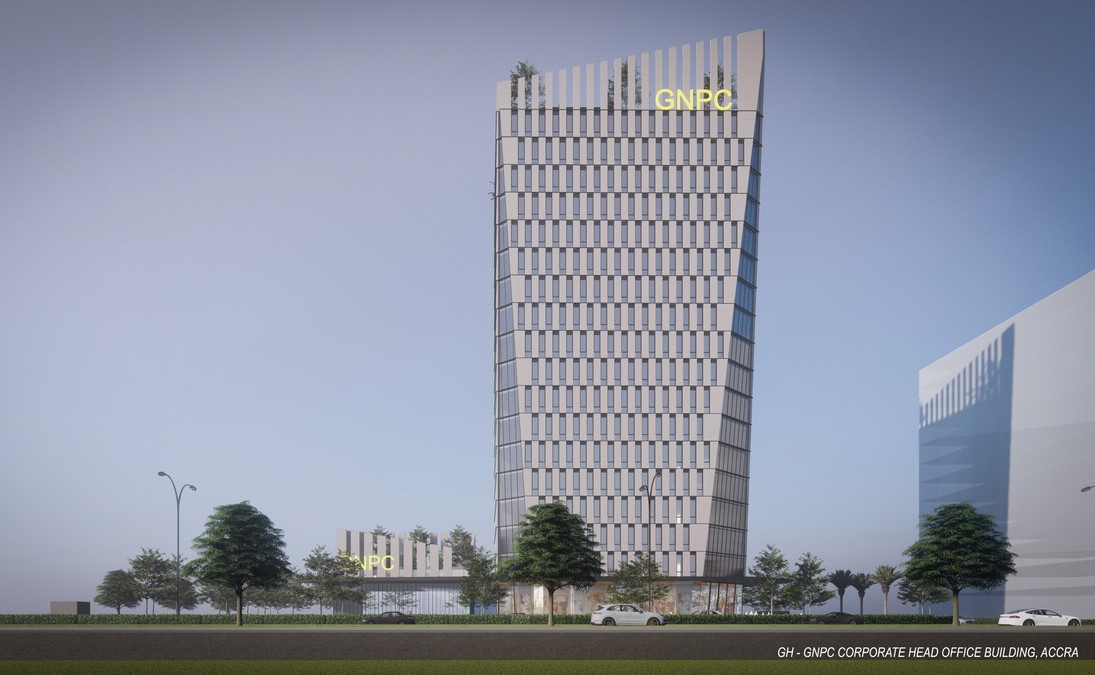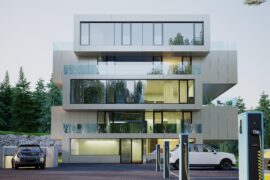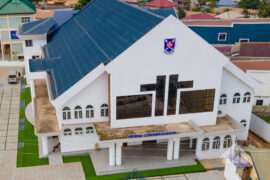Key Takeaways
- The GNPC Tower stands at 105 meters, making it the tallest building in Ghana and a symbol of urban development.
- Its architectural design features a striking glass façade and cantilevered floors, offering breathtaking views and innovative aesthetics.
- The building comprises 60 levels, providing a mix of office and residential spaces within a robust structural framework.
- Sustainable design practices include a green roof, solar panels, and rainwater harvesting, reducing environmental impact and enhancing energy efficiency.
- The GNPC Tower boosts tourism and represents Ghana’s cultural identity, merging traditional elements with contemporary architectural practices.
Overview of Ghana’s Tallest Building
When you step into the bustling city of Accra, you can’t help but notice the impressive silhouette of the tallest building in Ghana, the Ghana National Petroleum Corporation (GNPC) Tower. Rising to 105 meters, this architectural marvel not only dominates Ghana’s skyline but also symbolizes the country’s rapid urban development. The GNPC Tower embodies a modern vision for Accra, showcasing the potential for growth in a city that thrives on innovation and progress. As you gaze upward, you realize that this building represents more than just height; it’s a reflection of Ghana’s economic aspirations and resilience. The tower acts as a beacon for investors, drawing attention to the nation’s burgeoning oil and gas sector. Its presence inspires a sense of pride among locals, reflecting a future where urban landscapes evolve alongside cultural heritage. In short, the GNPC Tower is a pivotal player in reshaping the narrative of Ghana’s urban environment.Architectural Design and Features
When you explore the architectural design of Ghana’s tallest building, you can’t help but notice its unique structural elements that challenge conventional aesthetics. The thoughtful integration of sustainable design practices not only enhances its beauty but also sets a benchmark for future constructions. You’ll see how these features combine to create a landmark that’s both visually striking and environmentally responsible.Unique Structural Elements
There’s something striking about the architectural design of Ghana’s tallest building, which seamlessly blends modern innovation with cultural resonance. The unique structural elements create an impressive visual story that captivates all who gaze upon it.- The striking glass façade reflects the vibrant urban landscape, inviting natural light to flow throughout.
- Cantilevered floors extend dramatically, offering breathtaking views and an illusion of weightlessness.
- The incorporation of local materials pays homage to Ghanaian heritage, establishing a sense of place.
- The elegant curves and angles symbolize unity and progress, making it a landmark of aspiration.
Sustainable Design Practices
As you explore the architectural integrity of Ghana’s tallest building, you’ll quickly notice its commitment to sustainable design practices that not only reduce environmental impact but also enhance the well-being of its occupants. The integration of green materials throughout the structure signifies a bold step toward eco-friendly construction. Additionally, the building emphasizes energy efficiency through innovative systems that optimize natural light and ventilation. | Feature | Description | |———————–|——————————————-| | Green Roof | Insulates and reduces heat absorption | | Solar Panels | Harnesses renewable energy sources | | Rainwater Harvesting | Minimizes water waste and promotes reuse | | Low-VOC Paints | Guarantees healthier indoor air quality | | Energy-efficient Glazing | Enhances natural light while reducing heat loss | These elements illustrate a forward-thinking approach to urban architecture.Height and Dimensions
The towering silhouette of Ghana’s tallest building commands attention with its impressive height and striking dimensions. Standing at an incredible 300 meters, it redefines the skyline and showcases modern architectural prowess. Its height specifications not only symbolize ambition but also reflect the innovative use of building materials that guarantee durability and sustainability.- Height: 300 meters, dominating the skyline
- Floors: 60 levels, providing ample space for various functions
- Facade: A blend of glass and steel, offering a sleek appearance
- Base: A robust foundation designed to withstand natural elements
Historical Context and Development
While exploring the historical context of Ghana’s tallest building, you’ll uncover a narrative that intertwines architectural ambition with the nation’s evolving identity. This structure isn’t just a feat of engineering; it symbolizes urban development and progress in a country rich with history. | Year | Event | Historical Significance | |————|————————————|———————————-| | 1957 | Ghana’s independence | Marked a new era for nationhood | | 1980s | Urban migration surge | Increased demand for infrastructure| | 2000 | Initial planning for the building | A vision for modernity | | 2020 | Building completion | Represents Ghana’s architectural prowess | Each phase of development reflects a step toward modernity, showcasing how this building is a representation of Ghana’s resilience and aspirations. It stands as a beacon of hope, inviting further exploration into the depths of its historical significance.Economic and Cultural Significance
Ghana’s tallest building isn’t just an architectural marvel; it plays a pivotal role in the nation’s economy and culture. Its striking presence symbolizes modernity, attracting tourists and investors alike, and fostering a sense of pride among Ghanaians. You can feel the economic impact ripple through local businesses and job creation, transforming the skyline into a beacon of opportunity.- Boosts tourism, drawing visitors enthusiastic to experience its grandeur
- Serves as a hub for local and international business, fostering economic growth
- Represents Ghana’s cultural identity, merging traditional elements with contemporary design
- Enhances community engagement through public spaces and events
Notable Events and Activities
As visitors step into the tallest building in Ghana, they’re often greeted by a vibrant schedule of notable events and activities that highlight the structure’s role as a cultural and social hub. You’ll find that the building hosts a range of community outreach programs designed to engage locals and foster connections. These initiatives not only uplift the community but also promote social responsibility among businesses and visitors alike. Moreover, the skyscraper serves as a prime venue for cultural festivals, showcasing Ghanaian art, music, and cuisine. Picture yourself immersed in the colorful displays, experiencing the rhythm and vibrancy of Ghana’s rich heritage. These events attract diverse crowds, encouraging a sense of unity and celebration.Stunning Visuals of the Skyscraper
When you gaze upon the tallest building in Ghana, it’s impossible not to be captivated by its striking architecture and modern design. The skyscraper stands as a representation of innovative engineering, boasting an aesthetic that harmonizes with the skyline. Its visual impact is profound, drawing your eyes upward and inviting admiration from all angles.- The sleek glass facade reflects the vibrant colors of the surrounding environment.
- Unique geometric patterns grace its exterior, creating an eye-catching silhouette.
- At night, the building lights up, illuminating the city with a dazzling display.
- Surrounding landscaping and art installations enhance the overall experience, making it a true landmark.
Frequently Asked Questions
Who Designed Ghana’s Tallest Building?
You’ll find that Ghana’s tallest building reflects diverse architectural influences, showcasing a blend of modern aesthetics and local traditions. Its design inspiration stems from both cultural heritage and contemporary trends, creating a unique urban landmark worth exploring.What Materials Were Used in Its Construction?
In its construction, you’ll find innovative techniques and diverse materials. By sourcing local resources, builders guaranteed sustainability while enhancing structural integrity, demonstrating how thoughtful material sourcing can elevate both aesthetics and functionality in modern architecture.Is There Public Access to the Building?
Yes, there’s public access to the building, enhancing your visitor experience. You can explore its stunning architecture, enjoy breathtaking views, and immerse yourself in the vibrant atmosphere, making it a must-visit destination for everyone.Are There Any Restaurants or Shops Inside?
You’ll discover an impressive array of restaurant offerings and shops that enhance your shopping experience. Indulging in diverse cuisines while browsing trendy stores makes your visit both delightful and memorable, ensuring there’s something for everyone.What Is the Building’s Energy Efficiency Rating?
You’ll find that the building’s energy efficiency rating reflects its commitment to sustainable design. With innovative features reducing energy consumption, it stands as a model for eco-friendly architecture, ensuring a greener future for all.Conclusion
To wrap up, Ghana’s tallest building stands as a remarkable reflection of the nation’s architectural ambition and cultural identity. Its striking design and impressive height not only redefine the skyline but also symbolize the country’s growth and dynamism. You can’t help but feel a sense of pride and excitement when witnessing such a landmark, as it attracts tourists and businesses alike. Embrace the experience, and let this skyscraper inspire you to explore the vibrant pulse of Ghana’s urban landscape.Discover more from Ghana Scoop
Subscribe to get the latest posts sent to your email.





